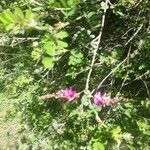Shrubs, 1-2(-3) m tall. Stems grayish brown, terete, with rounded lenticels, covered with appressed medifixed trichomes; young branches angular, with slightly spreading white medifixed symmetrically 2-branched trichomes. Stipules linear, ca. 3 mm, caducous, with appressed brown trichomes. Leaves 6-7 cm, (9-)13-25-foliolate; petiole and rachis adaxially grooved, with appressed medifixed trichomes; petiole 1-9 mm; stipels subulate, ca. 1 mm; petiolules ca. 1 mm; leaflet blades opposite, elliptic, obovate, or oblanceolate, 5-15(-25) × 2-10(-15) mm, papery, both surfaces with appressed white medifixed trichomes, midvein abaxially prominent and adaxially flat, secondary veins not visible, base broadly cuneate to rounded, apex obtuse to truncate and mucronate. Racemes 3-8 cm; peduncle (0.5-)1.4-2(-3) cm; young inflorescences in bud grayish green with few brownish hairs, rachis with dense appressed medifixed trichomes; bracts minute, caducous. Pedicel 1.5-3 mm, hairy, deflexed in fruit. Calyx 2.5-3.5(-4) mm, with appressed medifixed trichomes; tube ca. 1.5 mm; teeth triangular-lanceolate, 1.5-2.5 mm. Corolla purple to light purple; standard elliptic, 7.5-9(-13) × 4-5 mm, outside hairy; wings 7.5-10 mm, margin ciliate; keel 0.7-1.3 cm, outside apically hairy, margin ciliate, spur ca. 1 mm. Stamens (6-)7-11.5 mm; anthers ovoid-globose, base hairy. Ovary hairy, with 10 ovules. Legume brown, linear, cylindric, 1-1.5(-2) cm, glabrescent; endocarp purple blotched. Seeds 6-10 per legume, oblong, ca. 2.5 mm. Fl. May-Jun, fr. Jul-Oct. 2n = 16, 32, 48.
More
A shrub. It loses its leaves during the year. The bark is brown. The leaves have short stalks. They have leaflets along the stalk and the leaflets are opposite. They end in a sharp tip and are somewhat leathery. They are covered with short white hairs above and grey underneath. The flowers are pink. They are in short stalked arrangements. There are 10-20 flowers in a group. The fruit is a pod. It is like a cylinder with a few scattered hairs. It has 10-12 seeds.
A shrub, strigose with grey adpressed hairs. Leaves imparipinnate, common petiole 1 1/2-2 1/2 in. long. Leaflets opposite, 6-15 pair, oblong, or elliptic-oblong, mucronate, less than 1/2 in. long. Stipules subulate, deciduous. Eacemes short-pedunculate, as long as leaves; bracts subulate, deciduous. Calyx cup-shaped, the teeth longer than, or as long as, tube. Pod spreading, straight cylindric, 1 1/4 in. long, shining, with a few scattered hairs.


